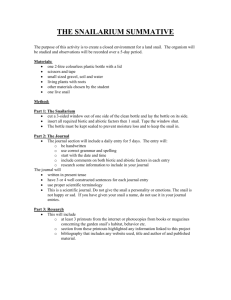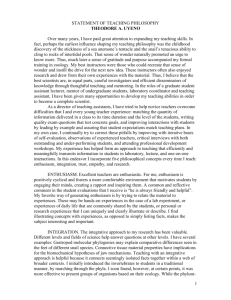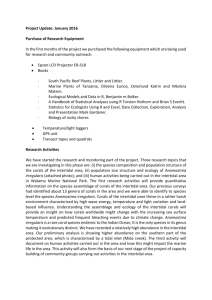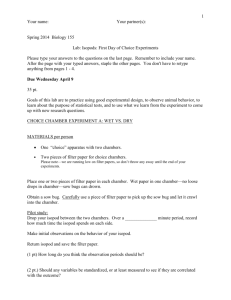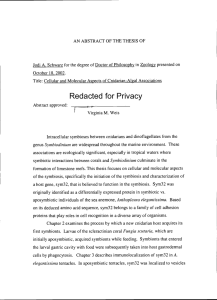Intertidal Stories: Research at Puerto Penasco
advertisement
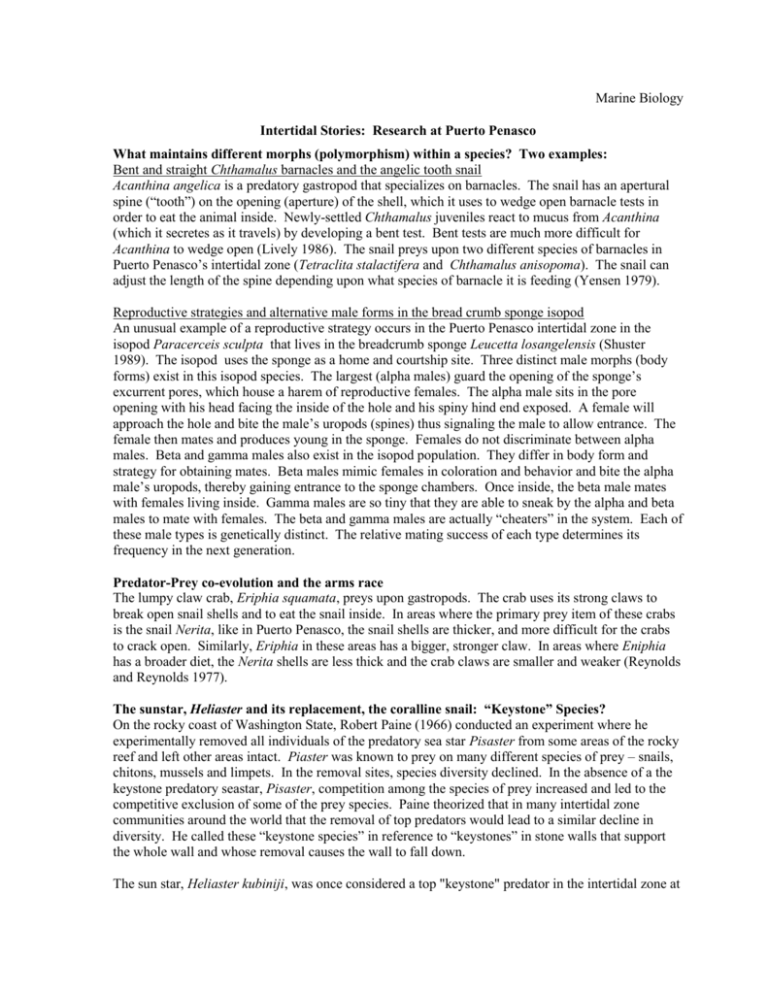
Marine Biology Intertidal Stories: Research at Puerto Penasco What maintains different morphs (polymorphism) within a species? Two examples: Bent and straight Chthamalus barnacles and the angelic tooth snail Acanthina angelica is a predatory gastropod that specializes on barnacles. The snail has an apertural spine (“tooth”) on the opening (aperture) of the shell, which it uses to wedge open barnacle tests in order to eat the animal inside. Newly-settled Chthamalus juveniles react to mucus from Acanthina (which it secretes as it travels) by developing a bent test. Bent tests are much more difficult for Acanthina to wedge open (Lively 1986). The snail preys upon two different species of barnacles in Puerto Penasco’s intertidal zone (Tetraclita stalactifera and Chthamalus anisopoma). The snail can adjust the length of the spine depending upon what species of barnacle it is feeding (Yensen 1979). Reproductive strategies and alternative male forms in the bread crumb sponge isopod An unusual example of a reproductive strategy occurs in the Puerto Penasco intertidal zone in the isopod Paracerceis sculpta that lives in the breadcrumb sponge Leucetta losangelensis (Shuster 1989). The isopod uses the sponge as a home and courtship site. Three distinct male morphs (body forms) exist in this isopod species. The largest (alpha males) guard the opening of the sponge’s excurrent pores, which house a harem of reproductive females. The alpha male sits in the pore opening with his head facing the inside of the hole and his spiny hind end exposed. A female will approach the hole and bite the male’s uropods (spines) thus signaling the male to allow entrance. The female then mates and produces young in the sponge. Females do not discriminate between alpha males. Beta and gamma males also exist in the isopod population. They differ in body form and strategy for obtaining mates. Beta males mimic females in coloration and behavior and bite the alpha male’s uropods, thereby gaining entrance to the sponge chambers. Once inside, the beta male mates with females living inside. Gamma males are so tiny that they are able to sneak by the alpha and beta males to mate with females. The beta and gamma males are actually “cheaters” in the system. Each of these male types is genetically distinct. The relative mating success of each type determines its frequency in the next generation. Predator-Prey co-evolution and the arms race The lumpy claw crab, Eriphia squamata, preys upon gastropods. The crab uses its strong claws to break open snail shells and to eat the snail inside. In areas where the primary prey item of these crabs is the snail Nerita, like in Puerto Penasco, the snail shells are thicker, and more difficult for the crabs to crack open. Similarly, Eriphia in these areas has a bigger, stronger claw. In areas where Eniphia has a broader diet, the Nerita shells are less thick and the crab claws are smaller and weaker (Reynolds and Reynolds 1977). The sunstar, Heliaster and its replacement, the coralline snail: “Keystone” Species? On the rocky coast of Washington State, Robert Paine (1966) conducted an experiment where he experimentally removed all individuals of the predatory sea star Pisaster from some areas of the rocky reef and left other areas intact. Piaster was known to prey on many different species of prey – snails, chitons, mussels and limpets. In the removal sites, species diversity declined. In the absence of a the keystone predatory seastar, Pisaster, competition among the species of prey increased and led to the competitive exclusion of some of the prey species. Paine theorized that in many intertidal zone communities around the world that the removal of top predators would lead to a similar decline in diversity. He called these “keystone species” in reference to “keystones” in stone walls that support the whole wall and whose removal causes the wall to fall down. The sun star, Heliaster kubiniji, was once considered a top "keystone" predator in the intertidal zone at Puerto Penasco. It is a voracious feeder on barnacles and mollusks. Up until 1978, it was extremely abundant (one individual per square meter) on the reef at Puerto Penasco. Then, it underwent a mass mortality and virtually disappeared from the Gulf of California (Dungan, et. Al. 1982). The mass dieoff has been associated with an increase in surface temperature due to an El Nino event. The sea stars developed white disease lesions, causing their bodies to "melt" and die. This natural mass decline in a presumed “keystone species” was predicted to precipitate a decline in the diversity of the rocky intertidal community. Fortuitously, data existed prior to the 1978 mass mortality that allowed for comparison with yearly population censuses following the mortality. Ed Boyer (1987) found the diversity at Station Beach was not affected though change did occur in the abundance of prey species and the competing predator species. The small predatory coralline snail, Morula ferruginosa, increased in abundance in the absence of Heliaster and appears to have taken over the ecological role that Heliaster played in feeding on barnacles. Heliaster is still uncommon but becoming more abundant in last ten years (1995 – 2005). Mutualism between anemones and corals and their symbiotic algae (zooxanthellae) Many shallow water corals and anemones form a symbiotic relationship with unicellular algae (dinoflagellates), called zooxanthellae, that live and photosynthesizes inside the cells of their host anemones and corals. Products of photosynthesis (glucose) from the algae leaches into host tissue, providing an important source of nutrition for the host anemones and corals. The endosymbiotic algae, in turn, receive a safe home as well as nitrates and carbon dioxide from the waste products of the host. This interaction is a mutualism since both participants benefit from the interaction. Palythoa ignota, the brown carpet anemone, is highly dependent on its symbiotic zooxanthellae for nutrition. It also uses its tentacles to suspension feed on small planktonic crustaceans in the water. Zoanthus danae and Porites californica (emerald coral) also have symbiotic relationships with dinoflagellates. Australian giant clams and some marine protozoans also live in a mutualistic symbiosis with zooxanthellae. Symbiosis with zooxanthellae causes many corals and anemones to appear brown. Other color in anemones and corals tends to be produced by the animals (maybe for sunscreen?) and not by symbiotic algae, though this is not well studied. Marine species rarely form symbiotic relationships with zoochlorellae (single-celled green algae).
